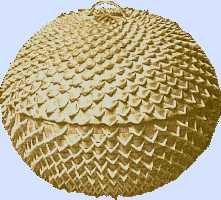|
"I was born in the north woods of northern Michigan, raised in lumber camps, where my father worked and our family stayed all winter, so I got very little education except nature. When my mother put me off her lap, so she could work at her baskets, she gave me some scrap material to play with -- that's how I learned to make baskets. I make only authentic Indian baskets, as my ancestors made. I work in my kitchen, after the splints are off the log, using only a sharp knife and a pair of scissors. I use black ash only. This is more of a hobby for me, I do not make a lot of baskets, perhaps 15 a year, and I only make them on order, which I never catch up with." -- Edith Bonde, 1975 letter to Smithsonian Institution Basketry Menu | |||
|---|---|---|---|
Basketry, Native Philosophy, Environment -- botanical guide to the plants used. Pollution kills basket ash trees | |||
California Basketry Story: Susan Billy, Pomo, describes 4 traditional Pomo basket plants, modern difficulties finding material. California Indian Basketmakers' Association -- pesticide difficulties.
| |||
Qualla Eastern Cherokee (Tsalagi) basketry-- Some history, traditions, plants used.
| |||
Gallery of baskets for utility, not art -- burden-carry, storage, fish trap, water bottles.
| |||
Multi-tribal Gallery: Northeast -- New England (U.S.) and Canada: Basketmaker-family traditions, from many tribes | |||
Dat-so-la-lee, Washoe woman whose life was fabricated by dealer to sell baskets (falsification of tradition, history, exploitation) how to briefly to describe this: (a) She was a real artist; (b) She was exploited; (c) The cynical fabrications. (NOT DONE) | |||
Linkpage of other Native basketry sites, articles, museums, sales galleries, theft notices. Yokuts gambling tray -- $48,000 | |||
Bibliography: Native Basketry. Man-in-th-Maze basket (Salt River Pima-Maricopa)
| Books about Native American baskets available from Amazon.com. Subscribe to American Indian Art Magazine
| ||


